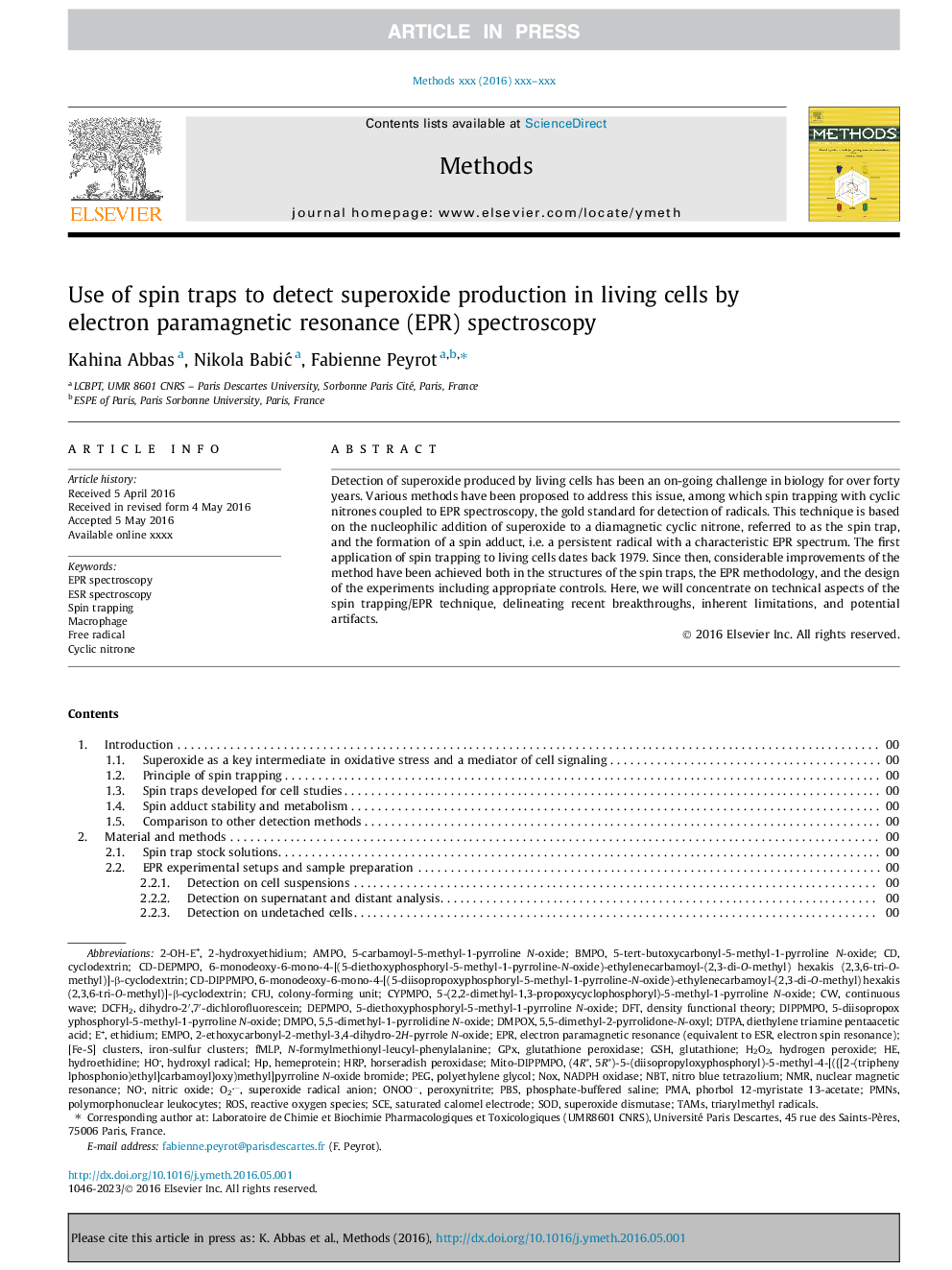| کد مقاله | کد نشریه | سال انتشار | مقاله انگلیسی | نسخه تمام متن |
|---|---|---|---|---|
| 5513673 | 1541217 | 2016 | 13 صفحه PDF | دانلود رایگان |
عنوان انگلیسی مقاله ISI
Use of spin traps to detect superoxide production in living cells by electron paramagnetic resonance (EPR) spectroscopy
دانلود مقاله + سفارش ترجمه
دانلود مقاله ISI انگلیسی
رایگان برای ایرانیان
کلمات کلیدی
BMPOGPXGSHHRPNBTDCFH2PMNsSCEphorbol 12-myristate 13-acetatefMLPDEPMPOTAMsAMPOPBSDTPADMPOXDIPPMPO5-diethoxyphosphoryl-5-methyl-1-pyrroline N-oxideN-formylmethionyl-leucyl-phenylalanineCFUDMPOEMPOnuclear magnetic resonance - رزونانس مغناطیسی هستهای2-OH-E+ - 2-OH-E +2-hydroxyethidium - 2-هیدروکسی تیدیمDFT - DFTPMA - LDC هاNOx - NOXO2− - O2-ONOO− - ONOO-ROS - ROSHydrogen peroxide - آب اکسیژنهSuperoxide radical anion - آنیون رادیکال سوپر اکسیدEthidium - اتیدیمESR spectroscopy - اسپکتروسکوپ ESRdiethylene triamine pentaacetic acid - اسید پنتاتیک دی اتیل تریامینSaturated Calomel Electrode - الکترودهای کالومل اشباع شدهNADPH oxidase - اکسیداز NADPH nitro blue tetrazolium - تترازولیم نیترو آبیNMR - تشدید مغناطیسی هستهای EPR - تشدید پارامغناطیس الکترونSpin trapping - تله اسپینIron-sulfur clusters - خوشه های آهن گوگردHydroxyl radical - رادیکال هیدروکسیلFree radical - رادیکالهای آزاد SOD - سدSuperoxide dismutase - سوکسوکس دیسموتازCyclodextrin - سیکلودکسترینEPR spectroscopy - طیف سنجی EPRpolymorphonuclear leukocytes - لکوسیت های پلی مورفونیک هسته ایMacrophage - ماکروفاژ Phosphate-buffered saline - محلول نمک فسفات با خاصیت بافریcontinuous wave - موج مداومDensity functional theory - نظریه تابعی چگالیNitric oxide - نیتریک اکسیدHemeprotein - هام پروتینHydroethidine - هیدروتیدینH2O2 - هیدروژن پراکسیدcolony-forming unit - واحد تشکیل کلنیHorseradish peroxidase - پراکسیداز هوررادیشPeroxynitrite - پروکسی نیتریتpolyethylene glycol - پلی اتیلن گلیکولPEG - پلیاتیلن گلیکول Glutathione - گلوتاتیونglutathione peroxidase - گلوتاتیون پراکسیدازReactive oxygen species - گونههای فعال اکسیژن
موضوعات مرتبط
علوم زیستی و بیوفناوری
بیوشیمی، ژنتیک و زیست شناسی مولکولی
زیست شیمی
پیش نمایش صفحه اول مقاله

چکیده انگلیسی
Detection of superoxide produced by living cells has been an on-going challenge in biology for over forty years. Various methods have been proposed to address this issue, among which spin trapping with cyclic nitrones coupled to EPR spectroscopy, the gold standard for detection of radicals. This technique is based on the nucleophilic addition of superoxide to a diamagnetic cyclic nitrone, referred to as the spin trap, and the formation of a spin adduct, i.e. a persistent radical with a characteristic EPR spectrum. The first application of spin trapping to living cells dates back 1979. Since then, considerable improvements of the method have been achieved both in the structures of the spin traps, the EPR methodology, and the design of the experiments including appropriate controls. Here, we will concentrate on technical aspects of the spin trapping/EPR technique, delineating recent breakthroughs, inherent limitations, and potential artifacts.
ناشر
Database: Elsevier - ScienceDirect (ساینس دایرکت)
Journal: Methods - Volume 109, 15 October 2016, Pages 31-43
Journal: Methods - Volume 109, 15 October 2016, Pages 31-43
نویسندگان
Kahina Abbas, Nikola BabiÄ, Fabienne Peyrot,